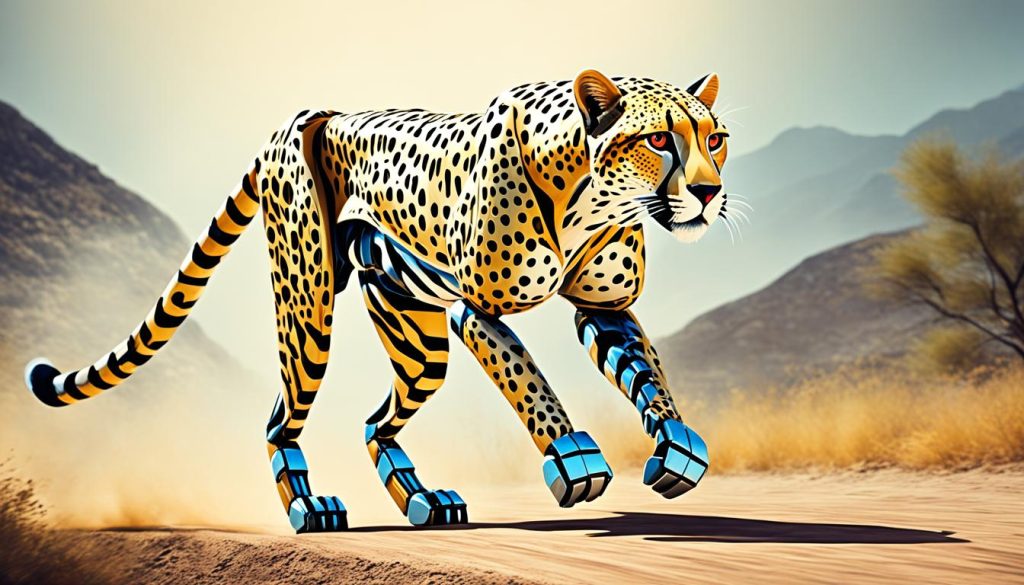Did you know that nature’s innovation over 3.8 billion years made some of the best designs? This process, known as biomimicry, copies nature’s patterns and strategies. It led to technologies like Velcro and the shape of airplane wings we use today.
In robotics, this idea of looking to nature has sparked big advancements. Robots are now inspired by living creatures and sometimes even have living parts.
Key Takeaways
- Biomimicry has led to the creation of innovative designs, such as Velcro and airplane wings, inspired by natural phenomena.
- Biohybrid machines integrate living cells or tissues into artificial devices, enabling them to sense, respond, and adapt to environmental changes.
- Soft robotics, inspired by the flexibility of octopus movement, allows robots to navigate complex environments and deliver medicine to specific body parts.
- Bee-inspired drones can communicate autonomously and are used in search and rescue missions.
- Gecko-inspired adhesives mimic the structure of gecko feet, enabling robots to climb walls without leaving residue and enhancing medical tools.
Biomimicry: Imitating Nature’s Designs
Scientists and engineers often look to nature for amazing ideas. They call this biomimicry. It means learning from natural designs to tackle human problems. The idea behind this is simple: nature has solved a lot of challenges already. By copying it, we can make tech that’s good for the planet and efficient.
Velcro and Airplane Wings: Early Inspirations
Velcro is a great example of nature inspiring a useful invention. George de Mestral saw how burrs stuck to his clothes in the 1940s. This observation led to the creation of Velcro. Also, humpback whales’ flippers design inspired better wind turbines and airplane wings. These designs help aircraft fly better by using less energy.
Biohybrid Machines: Integrating Living Cells
Biohybrid machines are machines with living parts that can act like living things. This field is pushing the boundaries of what machines can do. By joining together natural and artificial parts, we get amazing machines. One cool example is using spider muscles to move things that are very heavy.
Yet, using living things in machines brings up serious issues like ethics and safety. It’s a hard line to walk. Scientists must make sure they’re making well-thought-out choices as they explore this new area.
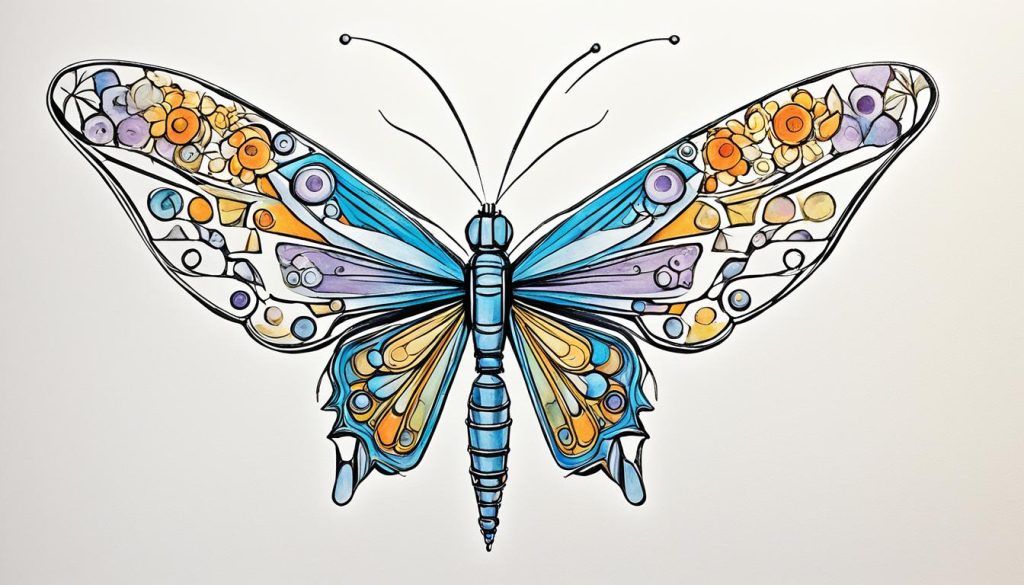
“Biomimicry is innovation inspired by nature. It’s learning from and then emulating nature’s forms, processes, and ecosystems to create more sustainable designs.”
– Janine Benyus, founder of the Biomimicry Institute
Soft Robotics: Learning from the Octopus
The soft-bodied octopus is an amazing creature that inspires the field of soft robotics. It is able to change shape and move through complex spaces. This inspired the creation of robots made with soft, flexible materials.
Flexible robots mimic the octopus’ abilities, letting them move easily. They can perform tasks like the precise delivery of medicines in the human body. This design approach from nature has led to incredible advancements in technology.
Flexible Robots for Medicine Delivery
Soft robots excel in the medical realm because they can work around the body’s features. They are perfect for delivering medicines in a focused way. This improves treatment results and lessens unwanted effects.
Soft robots are also very safe around people, aiding in non-invasive procedures and custom healthcare. The field of soft robotics promises better ways to treat diseases. It shows the future of personal, cutting-edge medical care.
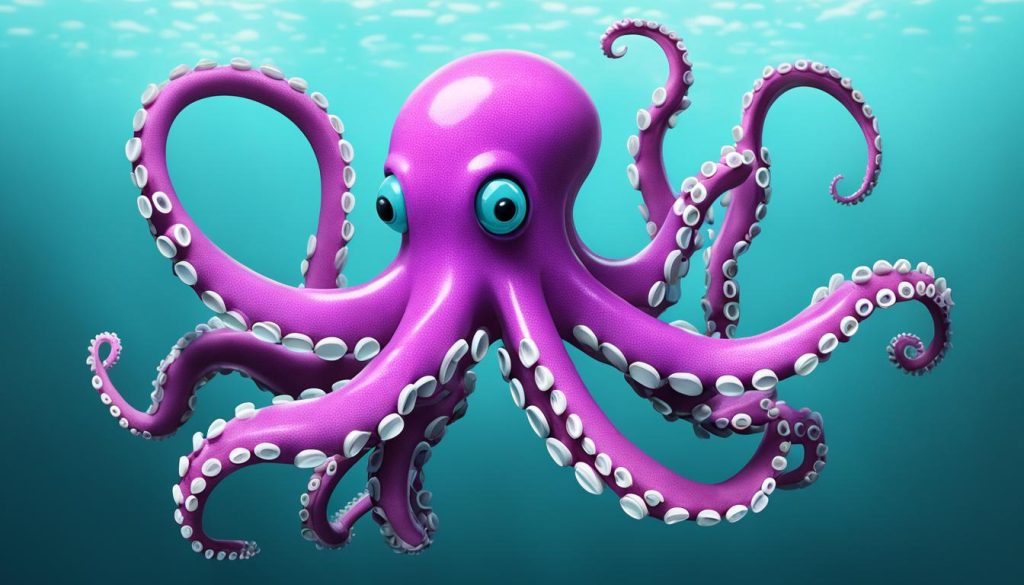
“Soft robots, with their ability to conform to complex environments, hold immense potential for transforming the future of medicine and healthcare.”
By learning from nature, scientists have developed flexible robots that can work inside our bodies. They can deliver treatments where they are needed most. This shows how powerful nature-inspired designs can be in improving health.
Swarming Drones: Inspired by Bees
Bees are famous for their teamwork. This has inspired the creation of small, independent drones. These little swarming drones act like bees, working together well. They can go into hard-to-reach places and handle tough jobs.
A team of scientists has made drones work together like a bee colony. These drones can build things up to 6 feet high with great accuracy. They are not only good at rescue missions. They can help build or fix stuff in places hard for people to reach.
These swarming drones succeed because they act like bees. Bees talk by moving and using smells to plan together. The drones use fancy sensors and talk to each other to get things done.
Bee-inspired drones are great for many things. They can help in emergencies or even go to space. Scientists are making them even better. One day, they might even build things anywhere, without humans.
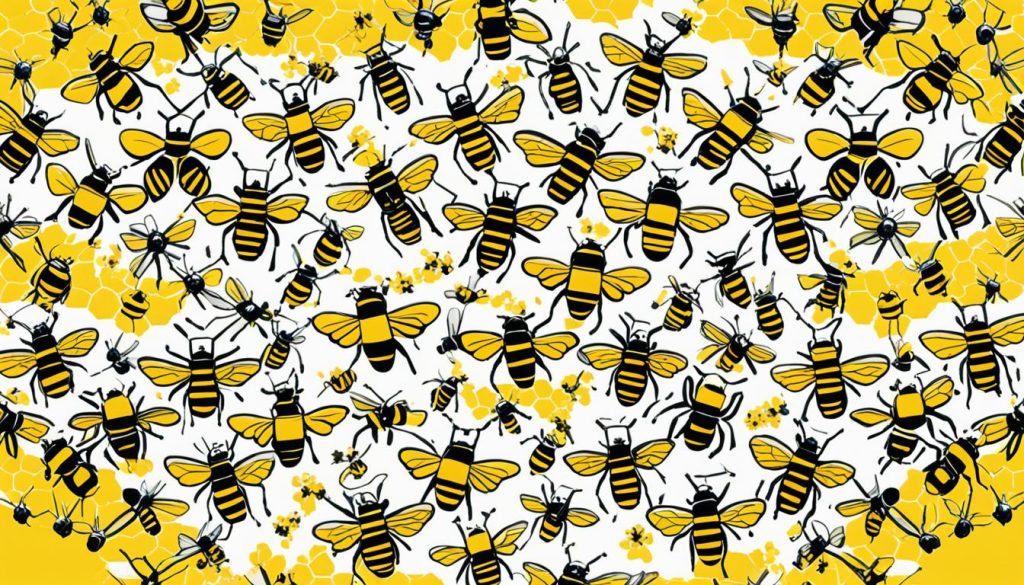
These drones show how amazing nature is. Copying nature helps us make new, cool things. As we learn more, nature will keep inspiring our technology. This way, we and nature can live in peace.
Nature’s Adhesives: Mimicking Gecko Feet
The natural world is full of amazing ideas that inspire scientists. One such idea is how geckos can climb up walls and hang upside down. They do this using tiny hairs on their feet that stick to surfaces. This power has inspired the creation of gecko-inspired adhesives. These adhesives are changing how we make things like robots and medical tools.
Wall-Climbing and Residue-Free Robots
Scientists have made wall-climbing robots by copying gecko feet. These robots can climb walls and ceilings without any sticky mess. This technology helps robots work in places like hospitals or old buildings without any harm. Also, it’s great for making tools, for rock climbing, and special bandages.
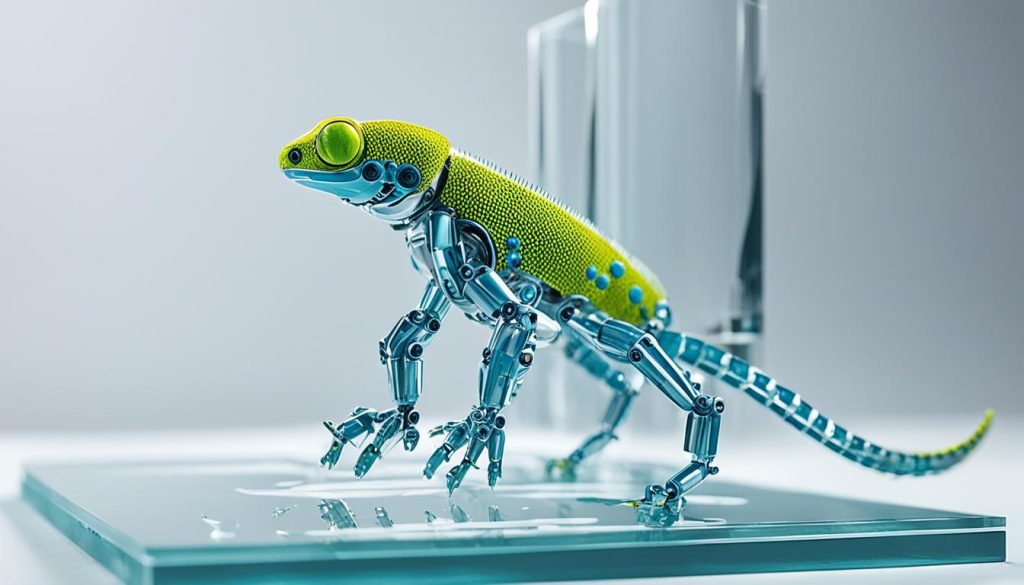
Dr. Jeffrey Karp, a scientist at MIT, is a leader in this area. His team works on glues and medical tools that work like gecko feet. They’ve made surgical glues that stop bleeding and tools for surgery that cause less harm.
“Biomimicry offers a wealth of untapped potential, as we continue to unravel the mysteries of the natural world and apply those insights to solve real-world challenges.”
Gecko-inspired adhesives are being used in many cool ways, from robots to medical devices. Learning from nature is helping us make new and better things. The door to new inventions is wide open. Nature has so much to teach us.
Fish-Inspired Swimming Robots
The natural world inspires many engineers and scientists. They aim to make new technologies by looking at nature. One exciting area is the creation of fish-inspired swimming robots. These robots copy the smooth, efficient movements of sea animals. The goal is to make energy-efficient aquatic robots. Such robots would move easily underwater.
Scientists have learned a lot by watching how fish swim. They use special materials and techniques to copy fish movements. Robots can now move like fish underwater. These underwater robots are good for many things. They help in the military, explore the seas, and clean up microplastics.
Energy-Efficient Aquatic Robots
Fish-inspired robots are great because they use energy well. Many underwater vehicles today use a lot of power. This limits their time in the water. But robots that move like fish use less power.
Take the Jellyfish-Bot, for instance. It moves slowly, at 6.1 cm/s, and uses little power, about 100 mW. This robot is quiet and can move things without touching them. It’s a useful robot for underwater work.
| Feature | Performance |
|---|---|
| Swimming Speed | 6.1 cm/s |
| Power Requirement | 100 mW |
| Robot Size | 16 cm diameter |
| Underwater Noise | Noise-free operation |
| Object Manipulation | Contact-free |
Because they use energy well, fish-inspired swimming robots can work a long time. They’re great for many jobs underwater. They help monitor the environment, do science, and clean up the water from microplastics.
Nature’s Blueprint: Designing Robots Inspired by Living Creatures
The area of bio-inspired design has really changed how we see robotics. Engineers and researchers now find solutions in nature’s blueprint. This has led to the creation of robotic systems that act and adapt like real creatures.
Take the “mini-bug” for instance. This micro-robot is very small, weighing only 8 milligrams. It moves as fast as 6 millimeters per second. Using a small shape memory alloy actuator, it can move up to 40 times per second, just like insects do.
Another example is the “water strider” micro-robot, at 55 milligrams. It’s made to walk on water, copying the abilities of its natural relative.
Designing nature-inspired robots often involves trying many designs over multiple rounds. By using AI, billions of designs can be tested quickly. The best ones are then chosen for more work.
Some researchers are even mixing biology with robotics. The story of the xenobots is incredible. They use living cells to heal and even make more of themselves. They can move, swim, and work together in piles.
The link between nature and robotics goes beyond just moving. Research on how birds fly, for example, helps make better drones. Even how ancient creatures move helps us imagine how modern robots could move.
The field of nature-inspired robotics is always progressing. New materials, control systems inspired by nature, and more are coming. The future of robotics is deeply connected to the amazing variety of life on Earth.
“Nature is the best engineer, and we have much to learn from it.”
| Micro-Robot | Weight | Speed | Actuator Details |
|---|---|---|---|
| “Mini-bug” | 8 milligrams | 6 millimeters per second | Shape memory alloy actuator weighing less than a milligram, can flap or kick up to 40 times per second |
| “Water Strider” | 55 milligrams | – | – |
Robotic Locomotion: From Cheetahs to Microorganisms
Scientists look to nature for new ideas in designing robots. They find inspiration in the speed of cheetahs and the small but efficient movements of microorganisms. This search in nature has led to novel ways of making robots move.
Biomimetic Muscles and Software Inspiration
Old robots used motors as their muscles. But the future will see robots with artificial muscles that work like real ones. These biomimetic muscles are flexible and fast, just like natural muscles. They are vital for future medical uses and advanced robots.
It’s not just the muscles; software is also getting a nature boost. Scientists made tiny robots that move in water like a Paramecium does. They have small hair-like parts, much like cells, to help them swim.
| Country | Nature-Inspired Innovations |
|---|---|
| Germany | Research on solar panels modeled after photosynthesis to increase efficiency in solar energy capture and conversion. |
| United States | Pioneering bio-inspired energy production, particularly through the National Renewable Energy Laboratory (NREL), focusing on enhancing the performance and sustainability of renewable energy systems. |
| Denmark | Leading in waste-to-energy initiatives, developing biomimetic designs for efficient systems that convert organic waste into clean energy. |
| Japan | Investing heavily in waste management solutions, including waste-to-energy technologies that replicate natural decomposition processes to convert organic waste into energy. |
Nature has a big impact on all types of robot movement. Whether from the quick action of a cheetah or the small steps of microorganisms, robotics keeps improving. It’s thanks to biomimetic muscles and nature-inspired software.
“Biomimicry, inspired by nature’s designs, has been utilized in various industries, such as construction and aerospace, leading to the development of lightweight and strong materials.”
Sustainable Materials: Stronger, Lighter, Self-Cleaning
Life is now about finding eco-friendly choices. Biomimetic materials are a great way to do this. They are inspired by nature and copy its amazing features. These materials are strong, light, and often clean themselves. They work well in many fields and are good for our planet.
Anthurium Leaves and Dragonfly Wings
The Anthurium plant is one cool example. It lives in the dark of the rainforest. Its leaves have tiny lenses that help it use light better for food-making. Now, we are using this idea for solar panels that work even when it’s not sunny.
Then, there’s the dragonfly’s wing. It helps the dragonfly fly, and it also kills microbes. This makes it keep clean by itself. Scientists made a material like this to avoid using harmful chemicals to clean.
| Biomimetic Material | Inspiration from Nature | Applications |
|---|---|---|
| Super-efficient solar panels | Anthurium plant’s microstructured leaves | Renewable energy generation in less sunny regions |
| Self-cleaning, bactericidal surfaces | Dragonfly wing’s nanostructures | Sterile surfaces for medical devices, building materials, and more |
These are just the start. Nature’s ideas are leading to great changes. Now, we are making new materials that are kind to the earth. They are also very good at what they do. This could reshape our world for the better.
“Nature has already solved many of the problems we are struggling with. Studying nature’s solutions can provide valuable insights and inspiration for developing new, sustainable materials and technologies.”
Renewable Energy: Termites and Artificial Photosynthesis
Biomimicry, learning from nature, is vital in creating new renewable energy solutions. Termite mounds have given us ideas for clever ways to control the environment. This is seen in buildings like the stunning Supertrees in Singapore, showing nature’s influence on human design.
Termites keep their homes comfy by using a smart method. They dig tunnels to get to water below, then let the water on the ground evaporate. Through this, they keep a steady, cozy temperature in their nests. This idea has been used in buildings as well, such as Melbourne’s Council House 2. They use water to cool down just like termites and have become much more energy efficient, saving up to 85% compared to other buildings.
Artificial photosynthesis is a new area in renewable energy, learning from plants. This technology can potentially make renewable energy from just water and carbon dioxide, with oxygen as the only waste. It’s like creating food and fuel from the air. Scientists worldwide are working on this to transform how we power our lives.
| Biomimicry in Renewable Energy | Impact |
|---|---|
| Termite mounds | Inspiration for energy-efficient buildings like Singapore’s Supertrees and Melbourne’s Council House 2, achieving 85% more efficiency |
| Artificial photosynthesis | Potential to create renewable energy sources from water and carbon dioxide, with oxygen as the only byproduct |
| Shark-inspired winglets on planes | Reduced drag and enhanced fuel efficiency in aviation technology |
| Humpback whale-inspired wind turbines | Improved energy efficiency through bio-inspired designs |
The link between nature and renewable energy is deepening, with new discoveries always appearing. By mimicking nature, we are advancing our efforts for a sustainable future. Biomimicry is a key in creating cleaner, more effective energy solutions.
Conclusion
Robotics and bioinspired robots are changing how we think about technology. They mix science and engineering in an amazing way. Bio-inspired robots are made to solve tough problems, like moving in hard places or helping in medicine. They do this by copying things from animals, plants, and tiny creatures. This mix of biology and robotics makes real change possible, using nature’s ways to find answers.
These robots copy the movements and changes of living things. This leads to new tech that respects the environment. For example, the ALPHA robot acts like the African dung beetle. And the Pollination Robot is helping bees by doing their work. These examples show how learning from nature is not just smart but can make a big difference in many areas.
Scientists are learning more about how nature works all the time. This research is the bridge to a promising future in robotics. By using nature’s ideas, engineers and scientists can make tech that’s smart, green, and advanced. This article ends by highlighting how bio-inspired robotics join nature and tech effectively. And how they offer new ways to meet the tough challenges we face.


